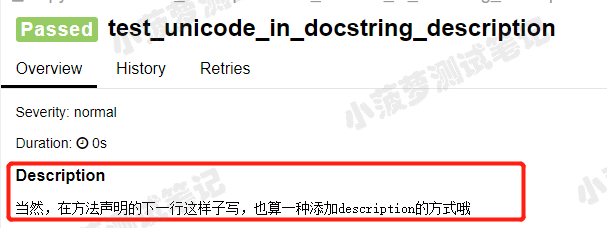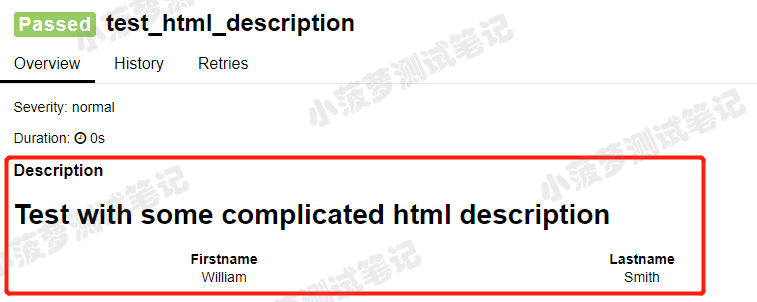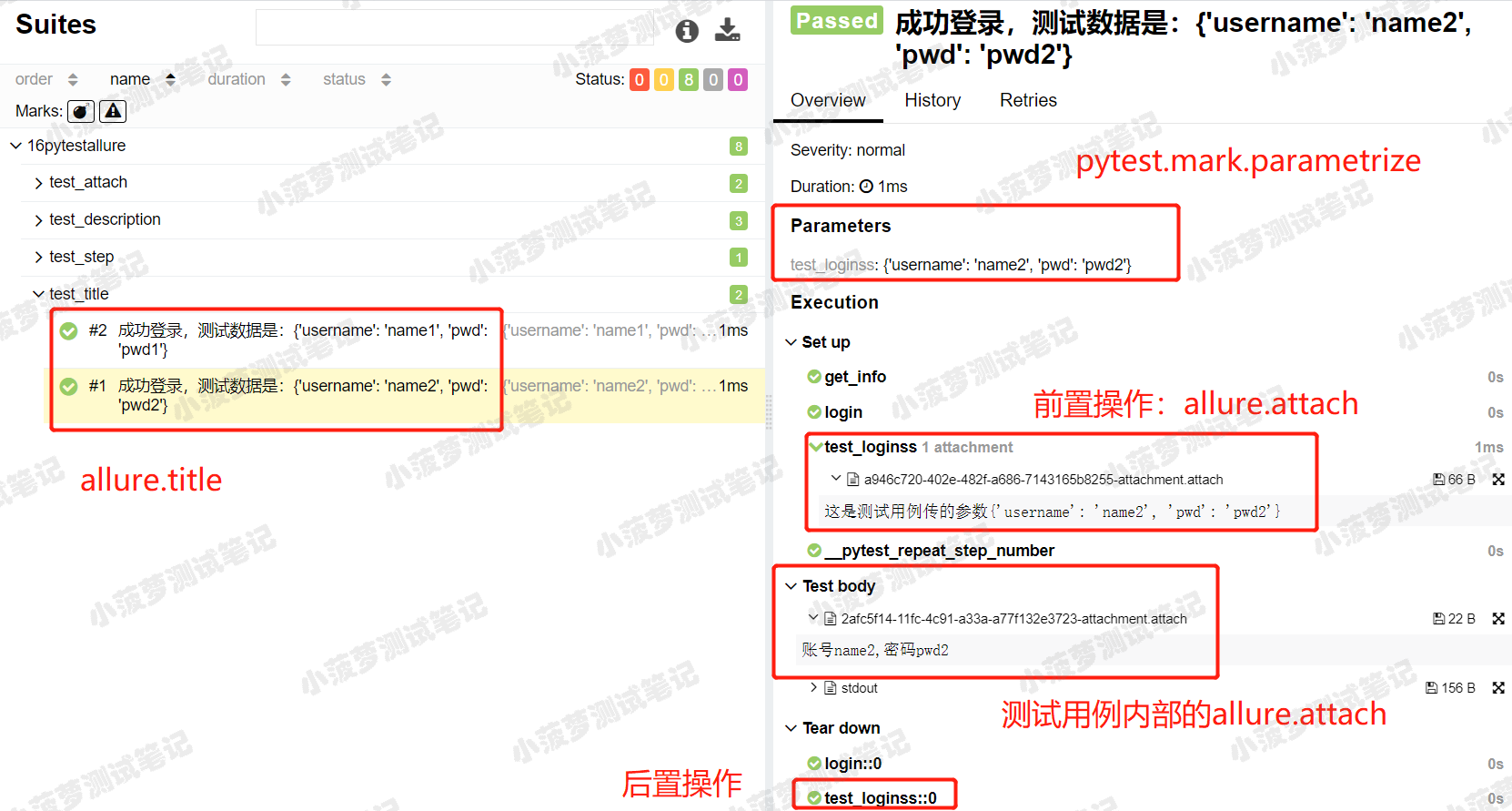Pytest系列(21)- allure的特性,@allure.description()、@allure.title()的详细使用
本文转自:https://www.cnblogs.com/poloyy/p/12726657.html
前言
上一篇文章介绍了两种allure的特性
- @allure.step() 装饰器:可以设置测试步骤,让测试用例的执行过程更加详细
- allure.attach() 函数:可以设置需要显示在allure报告的附件,包含了多种类型,可以通过allure.attachment_type查看支持的类型
这一篇幅,我们主要来讲解另外两个特性,可以增加报告的可读性哦!
- @allure.description()
- @allure.title()
它们用法极其相近,只是作用不一样而已
@allure.description()
作用
可以添加足够详细的测试用例描述,以便于管理层查看哦哈哈哈
语法格式,有三种
- @allure.description(str)
- 在测试用例函数声明下方添加 """ """
- @allure.description_html(str):相当于传一个HTML代码组成的字符串,类似 allure.attach() 中传HTML
注意:方式一方式二的效果和作用是一致的, 哪个方便哪个来
#!/usr/bin/env python
# -*- coding: utf-8 -*-
"""
__title__ =
__Time__ = 2020-04-18 15:24
__Author__ = 小菠萝测试笔记
__Blog__ = https://www.cnblogs.com/poloyy/
"""
import allure
import allure
# 方式一
@allure.description("""
这是一个@allure.description装饰器
没有特别的用处
""")
def test_description_from_decorator():
assert 42 == int(6 * 7)
# 方式二
def test_unicode_in_docstring_description():
"""
当然,在方法声明的下一行这样子写,也算一种添加description的方式哦
"""
assert 42 == int(6 * 7)
# 方式三
@allure.description_html("""
<h1>Test with some complicated html description</h1>
<table style="width:100%">
<tr>
<th>Firstname</th>
<th>Lastname</th>
</tr>
<tr align="center">
<td>William</td>
<td>Smith</td>
</table>
""")
def test_html_description():
assert True
方式一的allure报告
方式二的allure报告
方式三的allure报告
@allure.title()
作用
- 使得测试用例的标题更具有可读性,毕竟我们可以写成中文
- 支持占位符传递关键字参数哦(动态标题,结合 @pytest.mark.parametrize 使用)
具体栗子一
#!/usr/bin/env python
# -*- coding: utf-8 -*-
"""
__title__ =
__Time__ = 2020-04-18 16:09
__Author__ = 小菠萝测试笔记
__Blog__ = https://www.cnblogs.com/poloyy/
"""
import pytest, allure
@allure.title("前置操作:登录")
@pytest.fixture
def test_loginss(request):
params = request.param
name = params["username"]
pwd = params["pwd"]
allure.attach(f"这是测试用例传的参数{params}")
print(name, pwd, params)
yield name, pwd
@allure.title("成功登录,测试数据是:{test_loginss}")
@pytest.mark.parametrize("test_loginss", [
{"username": "name1", "pwd": "pwd1"},
{"username": "name2", "pwd": "pwd2"}], indirect=True)
def test_success_login(test_loginss):
name, pwd = test_loginss
allure.attach(f"账号{name},密码{pwd}")
运行结果,查看allure报告
这是一次综合多个之前学到的方法来完成的栗子,已经具体标出来啦!
具体栗子二
@allure.title("多个参数{name},{phone},{age}")
@pytest.mark.parametrize("name,phone,age", [
(1, 2, 3),
(4, 5, 6),
(7, 8, 9)
])
def test_test_test(name, phone, age):
print(name, phone, age)
运行结果,查看allure报告
总结
如果没有添加 @allure.title() 的话,测试用例的标题默认就是函数名,这样的可读性不高,毕竟咱们是中国人,显示中文title还是很有必要的~所以墙裂建议大伙儿加上啦!








